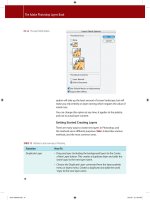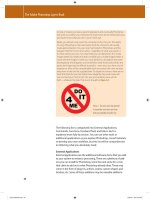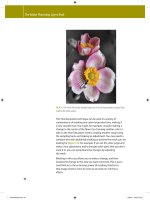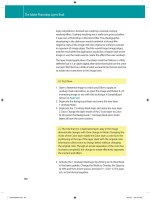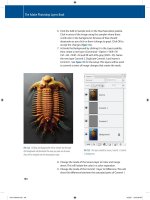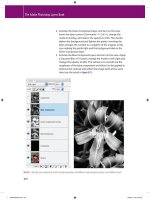the adobe photoshop layers book
Bạn đang xem bản rút gọn của tài liệu. Xem và tải ngay bản đầy đủ của tài liệu tại đây (19.6 MB, 320 trang )
Free ebooks ==> www.Ebook777.com
www.Ebook777.com
Free ebooks ==> www.Ebook777.com
The Adobe
Photoshop
CS4 Layers Book
www.Ebook777.com
This page intentionally left blank
The Adobe
Photoshop
CS4 Layers Book
Harnessing Photoshop’s most powerful tool
Richard Lynch
AMSTERDAM • BOSTON • HEIDELBERG • LONDON • NEW YORK • OXFORD •
PARIS • SAN DIEGO • SAN FRANCISCO • SINGAPORE • SYDNEY • TOKYO
Focal Press is an imprint of Elsvier
Free ebooks ==> www.Ebook777.com
Focal Press is an imprint of Elsevier
30 Corporate Drive, Suite 400, Burlington, MA 01803, USA
Linacre House, Jordan Hill, Oxford OX2 8DP, UK
© 2009, Richard Lynch. Published by Elsevier Ltd. All rights reserved.
The right of Richard Lynch to be identified as the author of this work has been asserted
in accordance with the Copyright, Designs and Patents Act 1988.
No part of this publication may be reproduced, stored in a retrieval system, or
transmitted in any form or by any means, electronic, mechanical, photocopying,
recording, or otherwise, without the prior written permission of the publisher.
Permissions may be sought directly from Elsevier’s Science & Technology Rights
Department in Oxford, UK: phone: (ϩ44) 1865 843830, fax: (ϩ44) 1865 853333,
E-mail: You may also complete your request online
via the Elsevier homepage (), by selecting “Support & Contact”
then “Copyright and Permission” and then “Obtaining Permissions.”
Notice
No responsibility is assumed by the publisher for any injury and/or damage to persons
or property as a matter of products liability, negligence or otherwise, or from any use
or operation of any methods, products, instructions or ideas contained in the material
herein. Because of rapid advances in the medical sciences, in particular, independent
verification of diagnoses and drug dosages should be made.
Library of Congress Cataloging-in-Publication Data
Lynch, Richard (Richard A.)
The Adobe Photoshop CS4 Layers Book : Harnessing Photoshop’s Most Powerful
Tool/Richard Lynch.
p. cm.
Includes bibliographical references and index.
ISBN 978-0-240-52155-8 (pbk. : alk. paper) 1. Adobe Photoshop. 2. Photography—
Digital techniques.
3. Image processing—Digital techniques. I. Title.
TR267.5.A3L949 2009
006.686—dc22
2008051098
British Library Cataloguing-in-Publication Data
A catalogue record for this book is available from the British Library.
ISBN: 978-0-240-52155-8
For information on all Focal Press publications
visit our website at www.books.elsevier.com
09 10 11 5 4 3 2 1
Printed in Canada.
www.Ebook777.com
To Violet Tamburrino, who continues to add color to all our lives.
This page intentionally left blank
CONTENTS
Acknowledgments ............................................................................................................... xi
Introduction ..........................................................................................................................xiii
Chapter 1: The Basics of Layers: Layer Functions and Creation .................. 1
What Is a Layer? ...................................................................................................2
Layer Palettes and Menus................................................................................7
Types of Layers ................................................................................................. 13
Layer Viewing Preferences ........................................................................... 15
Getting Started Creating Layers................................................................. 16
Exercise ............................................................................................................... 20
Summary ............................................................................................................ 28
Chapter 2: Layer Management: Concepts of a
Layer-Based Work Flow .............................................................. 29
The Outline for Image Editing..................................................................... 30
Setup ............................................................................................................. 31
Capture ......................................................................................................... 33
Evaluation .................................................................................................... 34
Editing and Correction ............................................................................ 35
Purposing and Output ............................................................................ 35
The Logic of Layers.......................................................................................... 36
When to Create a New Layer ................................................................. 37
Naming Layers ........................................................................................... 37
Grouping Layers ........................................................................................ 42
Merging Layers .......................................................................................... 47
Moving and Activating Layers.............................................................. 51
Clipping Layers .......................................................................................... 52
Linked Layers .............................................................................................. 56
Smart Objects ................................................................................................... 60
Summary ............................................................................................................ 63
Chapter 3: Object and Image Area Isolation in Layers .............................. 65
Isolating Correction in Adjustment Layers ............................................. 66
Detailing the Levels Slider Changes................................................... 67
Applying Levels for Color Correction................................................. 70
Isolating Image Objects ................................................................................ 74
vii
Contents
Adding Layers for a Change ........................................................................ 81
Simple Layer Repair Example ...................................................................... 82
The Art of Color Balance ............................................................................... 86
Summary ............................................................................................................ 87
Chapter 4: Masking: Enhanced Area Isolation
91
Expanding on Process.................................................................................... 92
Clean Up ............................................................................................................. 93
Reducing Image Noise .................................................................................. 94
Enhancing Natural Color and Tone .........................................................102
Add Soft Focus ...............................................................................................105
Color Enhancements ....................................................................................110
Sharpen and Enhance Contrast................................................................111
Additional Manual Sharpening ................................................................115
Summary ..........................................................................................................118
Chapter 5: Applying Layer Effects
121
The Basics of Effects and Styles ................................................................122
Saving Styles .............................................................................................127
Managing Styles ......................................................................................129
Manual Effects ................................................................................................130
Automated Manual Effects Tools .............................................................132
Combining Manual Effects and Styles ...................................................134
Summary ..........................................................................................................140
Chapter 6: Exploring Layer Modes
143
Layer Mode Behavior ...................................................................................144
Normal ........................................................................................................145
Dissolve ......................................................................................................146
Darken.........................................................................................................146
Multiply.......................................................................................................147
Color Burn ..................................................................................................147
Linear Burn ................................................................................................148
Darker Color ..............................................................................................148
Lighten........................................................................................................148
Screen..........................................................................................................149
Color Dodge..............................................................................................149
Linear Dodge ............................................................................................150
Lighter Color .............................................................................................150
Overlay ........................................................................................................150
Soft Light....................................................................................................151
Hard Light ..................................................................................................151
Vivid Light ..................................................................................................152
Linear Light ...............................................................................................152
Pin Light .....................................................................................................152
Hard Mix .....................................................................................................153
viii
Free ebooks ==> www.Ebook777.com
Contents
Difference ..................................................................................................153
Exclusion ....................................................................................................153
Hue ...............................................................................................................154
Saturation ..................................................................................................154
Color ............................................................................................................154
Luminosity .................................................................................................155
Separating Color and Tone ........................................................................156
Sharpening Calculation...............................................................................162
Summary ..........................................................................................................166
Chapter 7: Advanced Blending with Blend If
169
Blend If: An Overview ..................................................................................169
Knockouts ........................................................................................................177
Blend If in Compositing...............................................................................179
Blend If as a Mask ..........................................................................................190
Creating a Color-Based Mask ....................................................................191
Summary ..........................................................................................................199
Chapter 8: Breaking Out Components
201
A Historic Interlude .......................................................................................202
Creating Color from Black and White .....................................................202
An Alternative: Creating Filtered Color..................................................211
Separating a Color Image into RGB Components .............................216
Using Separations .........................................................................................221
Summary ..........................................................................................................226
Chapter 9: Taking an Image through the Process
229
The Image.........................................................................................................230
General Image Editing Steps: A Review ................................................231
Applying the Image Editing Checklist ...................................................232
Summary ..........................................................................................................254
Chapter 10: Making a Layered Collage or Composite Image
257
What Is a Collage?..........................................................................................258
Guidelines for Collage .................................................................................258
An Example Collage .....................................................................................259
Creating a Panorama....................................................................................262
Working with HDR Images .........................................................................264
Making an HDR Image ..........................................................................265
Create an HDR Image in Photoshop ................................................266
Automated HDR Conversions.............................................................268
Manual HDR Conversions ....................................................................269
Summary ..........................................................................................................273
Photoshop’s Essential Tools List ................................................................275
Exploring New Tools .....................................................................................276
ix
www.Ebook777.com
Contents
External Applications ...................................................................................277
Commands ......................................................................................................278
Functions ..........................................................................................................278
Freehand Tools ...............................................................................................281
Filters..................................................................................................................281
Index ............................................................................................................285
x
ACKNOWLEDGMENTS
F
ocal Press is to be commended for their excellent work and dedication to
authors. A sincere thanks to my publisher. Though the crew has changed,
the excellent staffing continues, and the book-writing projects that I was
all but ready to abandon because of previous publishers continue with
Focal Press. Thanks especially to Danielle Monroe, who measures time with
patience. Thanks as well to Kara Race-Moore for her excellent detailed work.
Thanks to Ben Denne for making sure we stayed on course, and to all the
others who previously helped me on my way at FP, including Paul Temme,
Emma Baxter, and Asma Palmeiro.
Thanks to the management at betterphoto.com, who established my online
courses, especially Jim Miotke and Kerry Drager. And thanks to the hundreds
of students who keep my eye on the ball as to what people learning the
program really need (and not just what is conceptually cool).
More thanks to those few trusted friends in the business: Greg Georges
(gregorygeorges.com) and Al Ward (actionfx.com), Todd Jensen
(thefineartoriginals.com, toadprint.com), Fred Showker (60-seconds.com),
Barbara Brundage, and Luke Delalio (lukedelalio.com).
Unbridled thanks to the home base for their patience, ability to plan around,
competence in objectively ignoring, and occasional input and inspiration:
Lisa, who is as delicious as her meals; Julia, whose spirit manifests in
spectacular ways that I hope to grow to understand; Isabel, who always has
a kind word for my most awful images; and Sam, whose bellows in the night
break glass.
Special thanks … Mitch Waite, Stephanie Wall, Beth Millett, Bonnie Bills, Pete
Gaughan, and Dan Brodnitz (see, it’s not all bad). And, of course, Robert Blake
for the “F”.
Thanks to nameless others, named here, who affect things in ways they
cannot know: Alan R. Weeks, Kevin Harvey, Larry Woiwode, Tony Zenos, Joe
Reimels, Hagen-Dumenci, Dr. Fun, Murphy (1988–2007), AT, VDL, VOL, TV, SB,
P-G, TC, DL, JK, and various Lynches, Nardecchias, and Hongs.
xi
This page intentionally left blank
INTRODUCTION
I
f you’ve picked up this book, you are familiar enough with Photoshop to
know layers are important, and smart enough to know they can help you
improve your images. I’ve been using layers for about 15 years, but I can still
remember how I worked before I was introduced to them and found out what
they could do for me.
Sometime in early 1993, just before I was introduced to Layers, I was working
for a how-to photography book publisher as an editor/designer. We had
Photoshop 2.5. I used Photoshop to make adjustments to scanned images
and make them ready for print. Photoshop was fairly new at the time; it didn’t
yet have all of the features that would, not much later, make it the industry
standard in image editing. One of the features yet to be adopted was layers.
The project I was working on included topographic maps for a book on
waterfalls. The book had been self-published by an author who added the
maps to the book to give the reader an idea of the landscape around each
of the falls. The author had public domain maps scanned and placed in the
book at the original size. At that size, the maps accounted for the bulk of
the original book. We made the decision to reduce the size of the maps to a
single page in the reprint to save space and make the whole landscape visible
at a glance while saving some money in production costs. Regrettably, the
author had the original maps, but not the image files from the scans. We had
to rescan the maps for the new book. In line with saving costs, we decided to
scan the images in-house.
It seemed scanning the maps should have been easy. The maps were way too
big for the flatbed scanner we had, but I figured I could scan the maps in parts
and put them together in Photoshop. I fit as much of a map as I could onto
the scanner and scanned it in even columns and rows, leaving a little overlap,
saving the scans to separate files. I’d planned to assemble them all later in
Photoshop like a puzzle (see Figure I.1).
I made all the scans, then made a new image large enough to hold all the
scans, and then started placing them in the image one at a time via copy
and paste. Placing the first image was easy, and everything at that point was
working as planned. The next image wasn’t nearly as easy. The lines for the
topographic maps didn’t line up very well. I tried moving the image in all
directions and doing some rotation, but I couldn’t get all the lines to match up
at one time, no matter what I did or how I fussed. When I got the lines near the
bottom to align, the ones at the top would be off, and if I nudged right or left,
it would fix one thing and goof up something else.
xiii
Introduction
(a)
(c)
(b)
FIG I.1 (a) The topographical map was far too big to fit on the flatbed scanner. (b) The plan was to scan the map in pieces and fit them all together. (c)
When reassembled the new map would look like the original whole … at least that was the plan.
As it turned out, lining up the pieces of the map was a nightmare. I did the
best I could aligning that second piece, and finally decided it would never
align perfectly—it seemed I was a victim of scanner distortion in addition to
lacking perfect alignment between scans. When I deselected the pasted
piece, it merged with the original, misaligned gradation lines and all (see
Figure I.2). All I could do was Undo and try it again or move on to the next piece.
None of the subsequent pieces aligned perfectly, and I was left with many
disconnected gradation lines.
FIG I.2 The gradation lines
mismatched every time a piece was
put in place.
xiv
Introduction
I continued putting the pieces together and after I was all done I went back
and painstakingly corrected every line by manually patching (a technique
we’ll look at later in this book). It took many hours of additional time to make,
finesse, and blend all of the repairs to make the gradation lines look right.
When I finished the first map, I went to work on the next map. It took weeks to
complete them all.
Several months after the map project, Adobe released Photoshop 3. I read
about the new version, which featured Layers as the key new addition. Layers
were a way to let you store parts of your image independently in the same
image, letting you stack your changes without committing them. Instead
of the situation you had before, in which selected parts of the image would
automatically merge into a single image plane when deselected, you had
the option of keeping the area separate. Layers offered the opportunity to
reposition the objects you had on separate layers at any time.
I thought back to the maps and how even that simplistic view of layers would
have saved me hours of time. I could have pasted the separate scans to their
own layers so I could move each independently even after I had all of the
scans in one image (see Figure I.3).
FIG I.3 Layers would allow image areas to remain separated as if each were placed on its own pane of glass in the image.
There were many other advantages to layers that I would discover in the
coming months that went far beyond the simple way I first thought of them.
I would have power over opacity and could lower it for any given layer (say,
to 50 percent) to see through to the content of the layers underneath and see
better how the layers might align. I would be able to erase areas of the map
that I was adding to blend the overlap optimally and with more forgiveness
and lessen or eliminate the need for patching. I could have made patches
xv
Introduction
for the gradation lines in new layers and greatly simplified blending in those
adjustments. In all, the advantages of layers would have cut the work I had to
do on the map by days, not just hours.
Over the years and through the next six-plus versions of Photoshop, I would
discover many other uses for layers, including:
●
●
●
●
●
●
●
●
●
●
Using layers to allow completely nondestructive image editing. Editing
images would never lead to loss of the original source.
Using layers as the center of the image correction work flow. Layers could
store every step in the editing process for later examination, changes, or
learning about techniques.
Using layers as an organizational tool for all corrections. Layers can be
grouped and structured to organize selective and global corrections.
Using layers to store multiple versions of an image all in one file. Various
versions of an image can be stored in separate groups so there is no
hunting for files or unnecessary file duplication.
Using layers to leverage advantages of other color modes without
converting from RGB (red, green, blue). Working on separate image
components does not require a mode change when you use layers to
isolate color and tone.
Using layers to create custom CMYK and duotone separations for print,
allowing ultimate flexibility and control of print results on printing
presses.
Using layers to mix channels and perform calculations. With infinitely more
flexibility than standard tools like Channel Mixer or Calculations, layers are
the ultimate in creating masks and black-and-white conversion.
Using layers for repeatable custom effects. Along with custom color and
tone adjustments, custom sharpening, soft focus, and other special effects
are all possible.
Using layers to enhance control of the application of any tool in
Photoshop. Filters, painting tools, and all adjustments can be masked,
moved, and applied in different modes and opacities.
Using layers for compositing images, creating panoramas, and extending
visual depth with high dynamic range (HDR) effects.
Layers has seen some enhancement, though it was remarkably well matured
in that initial release. Layer functionality then and now includes some
extraordinary powers that, even now, I have still barely seen mentioned in
tutorials and books and even then never explored to potential. In this book
we take a look at them all, and focus on those that you will find most useful
every day.
Layers—what I consider the most powerful tool in all of Photoshop, a feature
in Photoshop used so extensively that it will effect the correction of every
image—had never been the subject of a book until the first edition of this
book appeared in 2007. This is very surprising considering that more esoteric
features such as Channels and Actions have books written about them.
xvi
Introduction
Every Photoshop book worth the paper it’s written on mentions layers, and
some have dedicated chapters to them, but no other book focuses on using
Layers as the core of your methodology for obtaining the best images, every
time, with the least amount of work. This book paved that new direction and
continues to lead the way.
The Goal of This Book
The goal of The Adobe Photoshop CS4 Layers Book is to give the reader a
complete approach to editing images using Layers as a springboard to better
corrections and a complete work flow. This book will show that layers are the
catalyst to organizing corrections, solidifying work flow (the holistic process
of editing images) and acting as the central component to controlling every
image change. Readers will learn professional correction techniques that are
viable in any image, and they will become familiar with the power of layers as
an organizational, correction, and revision tool. The ultimate goal is to portray
layers as the heart and soul of image correction and build a foundation of
good practices to help approach correction and enhancement of any image.
The book focuses on the correction of photographic images rather than using
layers for general graphics; the name of the program is, after all, Photoshop.
Although the focus is on image correction, the exploration of layer functions
and features is comprehensive.
Users need to understand how using layers can have an immediate, profound,
and long-term effect on the overall quality of their images. This book shows
not only the nuts and bolts of what layers do, but also how they envelop the
entire process of image correction and control.
Achieving the Goals
The process of discovering layers starts with the essence of learning what
layers are and exploring the Layers interface and commands in detail, then
works back through the application of layers in real-life image editing
situations using images found on the CD. The approach looks at the
fundamentals of images and image editing and shows how layers enable
users to make any adjustment to an image in a nondestructive fashion using
essential tools and concepts. Nondestructive techniques means enabling
users to make image changes that in no way compromise original image
information; layers build on top of the original source to alter it, rather than
changing it directly, which could lead to losing or permanently altering
valuable details.
The techniques provided in this book help you take your corrections to
a professional level without hocus-pocus or steps that are impossible to
comprehend and apply to your own images. You’ll see what happens behind
the scenes in step-by-step procedures, and when appropriate, you’ll be given
the tools—customized actions created just for this book—to move through
those steps quickly to set up image editing scenarios.
xvii
Introduction
This book will divulge:
●
●
●
●
a process of approaching image corrections (a work flow) centered on
layered development with proven methods and a proven, core tool set;
high-powered editing techniques and scenarios that leverage the power of
layers to enhance your ability to make any image adjustment;
realistic image editing situations with real images by using realistic
expectations to get real results;
timeless techniques that span many versions of Photoshop based on good
core fundamentals and essential understanding that can be used with any
image.
The book will not:
●
●
●
show you fleeting techniques that emphasize the newest tools just
because they are new;
examine a plethora of rarely used tools in excruciating detail just because
they are there;
show you how to create effects that you may use once in a lifetime—if ever.
Who Should Read This Book
This book is for anyone who is serious about enhancing his or her Photoshop
skills and getting better results from all of his or her digital images. It applies
to those who use either a digital camera or a scanner with a Mac or PC.
Readers of this book should probably not be absolute beginners with
Photoshop. They should at least have dabbled in using layers, perhaps
knowing they could make more of them.
It is assumed that readers are familiar with the basic Photoshop tools (or that
they are competent to research these in Photoshop Help) and that they have
fairly good general computer skills (there is nothing here about program
installation, troubleshooting, or the like). This book is written for:
●
●
●
users who want to understand how to use layers optimally for
nondestructive adjustment and organizing image corrections;
serious hobbyists who want to get more from their investment in
Photoshop by leveraging the power of its most potent tool;
those with some Photoshop experience who are looking for an organized
approach to editing any image and getting consistently better image
results.
How This Book Is Organized
As you go through the book, you will discover a mixture of practical theory,
examples of the types of changes you’ll make in images daily, and projects
to work on to help you understand the process as well as why it works.
Projects are devised so that you see what goes on behind the scenes to help
xviii
Free ebooks ==> www.Ebook777.com
Introduction
understand what you have done, not so that you just complete an exercise
or press a button and ogle the result. When you understand concepts and
techniques, you can apply that understanding to other images predictably—
either by using tools provided to drive the processes or by manually applying
learned techniques.
The book helps establish a routine so that you set clear goals for editing your
images and establish a method of approaching your images consistently.
The examples provided ensure that you can see the changes when they have
achieved the desired result. This understanding will enable you to apply the
techniques you learn to other images so that your images can be improved
consistently.
In Photoshop, many tools and functions can be accessed by more
than one method. When following along with the book’s step-by-step
instructions, use the suggested steps for accessing the tools. Using other
methods may cause sequences to behave unpredictably. For example,
opening Levels with the keyboard shortcut (CommandϩL/CtrlϩL) will
open the Levels dialog box but will not produce an Adjustment layer,
and this can affect the outcome of a procedure that depends on the
Adjustment layers being created.
You will learn multiple color-separation methods to take apart image color
and tone, as well as different ways to isolate color components, image
objects, and areas. When you can isolate colors and image areas, you can
correct those areas separately from the rest of the image and exchange,
move, and replace elements to make better images. You can also effect
better blending between areas and make more realistic changes. Actions
included on the CD are introduced in the exercises and will reveal functional
scenarios that can be used with any image and simplify the process of
applying what you learn.
The chapters build from one to the next, each using some ideas from the
previous chapter(s), building to chapters that follow the image process
from beginning to end by using a single image. Chapters incorporate mini
exercises that invite the reader to “ Try It Now,” using a hands-on approach to
learning. All images used in these exercises are on the CD so the user can work
along, and in many cases completed samples, including the layers used and
developed in the steps, are also provided so that you can check your work.
No book of any length can completely explore every facet of every concept,
but it should give you a good idea of the possibilities. To that end, each
chapter ends with a segment that considers the implications of using the
xix
www.Ebook777.com
Introduction
techniques and concepts you’ve learned in that chapter. The purpose and
content of each chapter are listed below:
Chapter 1: The Basics of Layers: Layer Functions and Creation
Understanding how to work with layers starts with understanding some basics
about what layers are, what their capabilities are, what functions are in the
Layers palette, and how to locate all that you need to apply basic layer power.
Readers will explore the Layers palette, see how all the basic functionality
fits into the Layers palette and menus, learn how to create layers, access and
apply basic layer functions, and adjust the layer viewing preferences. We’ll run
through a hands-on no-knowledge-necessary example of using layers and see
some simple effects that can be achieved in the world of layers.
Chapter 2: Layer Management: Concepts of a Layer-Based Work Flow
Before readers really become enamored with layers, the flexibility that they
offer, and the organization they provide, they need to know their practical
application—and then how to use them most effectively. There are reasons
to create layers based in the scope of layer capabilities and the changes you
want to make; in a similar vein, there are reasons not to create layers, reasons
to delete or combine layers, and means of managing layer content such as
merging, linking, and grouping. Effectively managing layers and layer content
will help keep image corrections on track, will allow users the flexibility to
step back in corrections, and will also keep image file sizes from bulking up
unnecessarily. This chapter includes a brief discussion of layer types, such
as Type and Adjustment layers, linking, alignment, activating, deletes, and
duplication. Readers will test out all the layer creation and combining features
and will be introduced to the steps of a digital work flow.
Chapter 3: Object and Image Area Isolation in Layers
The core strength of layers comes from their ability to help you isolate change.
This chapter begins to look at how to isolate image areas effectively. Sure, you
can isolate areas with selection, but selection has disadvantages in that changes
are permanent and selected areas are only temporarily isolated, rather than with
layers, with which changes remain permanently isolated and can be adjusted.
Layers enhance your freedom to correct the image because once areas are
isolated, you can make adjustments and then fine-tune the adjustments in ways
that are impossible with simple selective change. We’ll look at using layers to
isolate image areas and objects using copy and paste and applying a simple
layered effect using layer styles and manual effects. We’ll also look at blending
layers using Opacity, compositing images, and controlling composition.
Chapter 4: Masking: Enhanced Area Isolation
Even more advanced means of isolating image areas in layers exist in the
form of masking. Masking is making adjustments to the visible image without
actually changing or removing image areas; areas are hidden, or masked, in
the image based on a masking component, which acts separately from the
xx
Introduction
pixels. We’ll look at masking as it applies to layer transparency, layer clipping,
Adjustment layers, and proper layer masks. We’ll use layer masking to paint in
effects, affect image sharpness selectively, and change image color selectively.
Chapter 5: Applying Layer Effects
With the ability to isolate image areas comes the advantage of applying
layer-based effects. We will look at the effect possibilities, practical uses, and
applications. We’ll consider the difference between Fill and Opacity, and
peek around the corner to Chapter 6 and revisit part of Chapter 1, looking at
creating layer effects using standard layers. Using concepts from Chapters 3
and 4 to isolate and mask image areas, we consider the advantage of creating
effects manually rather than using packaged effects.
Chapter 6: Exploring Layer Modes
People who get involved in using layer modes often just apply them willynilly, like filters, and experiment till they see something that they like. There
is a better approach to layer modes: actually knowing what they do and
when they can be helpful. Not all layer modes are really useful for everyday
correction, but some are and they are very powerful tools. We’ll look at ways
that users can use layer modes every day for image enhancements and
improvements. Calculations help make simple separation of images into
color and luminosity components, which in turn allow a peek at what
modes do and allow useful change. Manual effects like dodge and burn,
image comparison, contrast enhancement, and more are all enabled by layers
and modes.
Chapter 7: Advanced Blending with Blend If
Photoshop has several advanced blending modes that allow users to
blend layers based on components/channels, qualities in the current
layer, and qualities in layers below the current layer. This capacity is mostly
encompassed by Blend If and component targeting. These powerful tools are
often great to use as adjuncts to more familiar layer tools, but we will explore
examples of more than one type, in practical examples that use Blend If for
image change. We’ll also load up some tools that make using Blend If an easy
part of everyday corrections.
Chapter 8: Breaking Out Components
As per the previous chapters we will look at ways to leverage the power
of layers to separate out image areas into RGB channels. These powerful
methods of separating images into components can lead to a plethora of
advantages in creating layer-based masks based on specific image qualities
and can open the door to a world of creativity in manipulating tone, color,
shape, and composition. Custom tools are provided for users to create
involved image scenarios that allow layer-based channel mixing of different
sorts and target tone and color change in a more powerful way than other
channel mixing options or controls offered as standard Photoshop tools.
xxi
Introduction
Chapter 9: Taking an Image through the Process
Now that we have explored the parts of layers and what they can do, we will
look at applying layers as a complete process to an image from beginning to
end. This chapter offers the opportunity to review every preceding chapter as
part of an actual application in image correction, as we explore concepts and
changes in a single sample image. The sample offers the opportunity to create
focus on the work flow and process and instill the idea of outlining what to
do with an image before approaching corrections and shows how to keep
everything organized during the process.
Chapter 10: Making a Layered Collage or Composite Image
As an exercise in creativity and an opportunity to break out all the tools that
readers encountered in the course of this book, the final chapter is devoted to
exploration of compositing and collage work. The emphasis is on considering
the idea of collage, and then looking at how to expand your canvas and image
depth, working with panoramas and HDR images implemented using the
power of layers. Source images are provided from the examples in the book
for looking at panorama stitching, composites, and collage and rendering
an HDR image. Readers will be encouraged to exercise their layer muscles by
using techniques from previous chapters to make a creative collage from a
variety of source images and are invited to share those with other readers on
the photoshopcs.com web site.
The CD
One of the most important parts of this book is the CD. First, the CD contains
all the images from the book so that readers can work through the corrections
exactly as they are portrayed. Second, the CD contains a set of custom actions
that will help readers set up scenarios in their images and repeat long sets of
steps that are in the book but would otherwise be tedious to apply. To use the
actions and simplify procedures you’ll have to do nothing more than load and
run an action. These actions/tools are meant for readers of this book only and
should not be shared freely with other Photoshop users. The actions must be
installed into Photoshop via the Actions palette to be accessible (instructions
are included below and in the appropriate chapter). The CD, images, and
actions will operate on Windows and Macintosh computers.
To install the actions, first locate the Actions folder on the CD. Actions in this
folder can be dragged directly to the Actions palette in Photoshop, or they
can be loaded through the Load Actions function on the Actions palette
menu (see Figure I.4).
After you’ve installed the actions, you’ll be able to access them in the Actions
palette. Open the Actions palette by choosing Actions from the Window menu.
The usage of the actions is discussed in this book, and all are described in the
Readme file for the actions on the CD. Please make use of the web site for the
book and use the online forum to discuss any problems you may be having with
the CD. Find links for the forums on the web site: .
xxii
Introduction
FIG I.4 Open the Actions palette from the Photoshop Windows menu, then choose Load Actions from the
palette menu.
The images used as practice files in the book are provided on the accompanying
CD so that readers can work along with the exercises. They are mostly provided
as .psd files (Photoshop documents) or .tif files, but may be in other formats
as appropriate to a particular exercise. These images are copyrighted and for
educational purposes only; please use them only in the context of the exercises.
Work with the images by opening them with Photoshop directly off the CD, and
save them as you need them to your hard drive. The images are all compatible
with Macintosh and Windows computers.
Mac and PC Compatibility
The actions and images on the CD are completely compatible with Mac
and PC platforms, and they work in the same way within Photoshop across
platforms. The greatest difference a user will note in the book is that shortcuts
differ between Mac and PC. For example, to open the Levels palette on a
PC, the user would press the CtrlϩL keys; on a Mac the user would press
xxiii
Introduction
the CommandϩL keys (Command is sometimes known as the Apple key).
Keyboard equivalents on Mac and PC are:
Macintosh
Windows
Example
Shift
Shift
ShiftϩX
Option
Alt
OptionϩX/AltϩX
Command
Ctrl
CommandϩX/CtrlϩX
Controlϩclick
Right-click
Controlϩclick/Right-click
All keystrokes are included in their entirety in the book, first Mac, then PC,
separated by a slash (/).
The Leveraging Photoshop Layers Blog
The Leveraging Photoshop Layers blog (web log) is like a newsletter that helps
keep you up to date on frequently asked questions, tips, and troubleshooting,
as well as topics of interest (recent postings before the publication of this
book centered on topics of color management). I post the blog so that
anyone can read it. Subscribers get notified of all updates and new articles.
Subscription is free, and the content is always available online. The frequency
of posts and updates will be at least every two months, but may be much
more frequent depending on activity on the web site. There are several ways
to subscribe. You can sign up on the web site for the method that best fits
your needs () or you can subscribe with feed
subscription services (e.g., ), RSS, or Atom reader.
Changes to Layers in Photoshop CS4
Several changes to CS4 have affected the use of layers, though core
functionality remains mostly the same. Features that affect layers include:
●
●
Adjustments palette shows settings for adjustments instead of floating
dialogs;
Masks palette for creating editable, feathered, density-controlled masks.
The Adjustments palette does not directly affect the performance of layers,
but it does change the work flow some. You’ll find you want to keep the
Adjustments palette in a prominent place, like you might keep the Info or
Layers palette, so that it will always be in view—or else you won’t have a way
to view your Adjustment layer settings!
The Masks palette offers some excellent control for masks that goes beyond
the call of standard masking. You can blur for blending without affecting the
content of your masks, and this can be readily substituted for any blurring
mentioned in the exercises in the text.
xxiv
